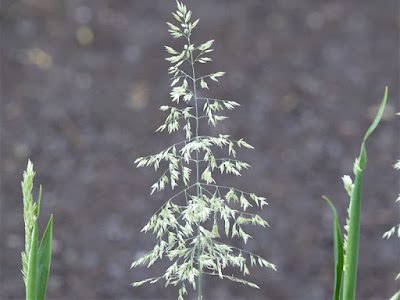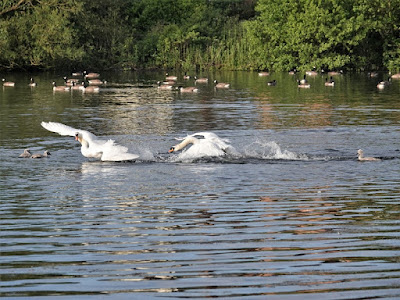7.0°C > 11.0°C: Today the early broken cloud cleared after 07:00 with wall-to-wall blue for a while. Later more cloud developed. Moderate / fresh westerly breeze. Very good visibility.
Sunrise: 04:39 BST
* = a species photographed today
! = a new species for me here this year
!! = a new species for me in Shropshire
Priorslee Balancing Lake: 05:05 – 06:20 // 07:25 – 09:50
(120th visit of the year)
The cool and breezy conditions seemed to impact the dawn chorus with the number of singing warblers lower than in recent days.
Bird notes:
- two Mute Swans visited briefly. I only noted them as they took off to depart. At least one was a first year bird.
- an Oystercatcher flew East over the dam at 08:45. Whether it flew over or had been on the south-west grass and had been disturbed by the arrival of the model boat club I cannot say.
- once more a Common Whitethroat was again heard alarm-calling at the West end at 5:10. It was noted carrying food. It then flew off in the company of two other birds that I could not identify from the brief view. One of them may have been a Reed Warbler that was, unusually, singing from inside the bramble thicket with the whitethroat.
Counts of birds noted flying over:
- 6 Canada Geese: a pair outbound; a quartet inbound
- 1 Greylag Goose: outbound
- 47 Wood Pigeons: 38 of these put up together from fields to the East. By ?
- 1 Oystercatcher: presumed overfly – see notes
- 3 Herring Gulls
- 2 Lesser Black-backed Gulls
Hirundines etc. noted: see notes
- c.35 Swifts
- 5 Barn Swallows
- c.8 House Martin
All in a swirling mass over the East end. Perhaps more.
Warblers noted (the figure in brackets relates to birds heard singing):
- 1 (1) Cetti's Warbler
- 10 (8) Chiffchaffs
- 7 (7) Reed Warblers
- 12 (11) Blackcaps
- 1 (0) Common Whitethroat: see notes
'nominal' warbler:
- 3 (3) Goldcrest
Counts from the lake area:
- 1 Canada Goose: briefly
- 4 Mute Swans: no cygnets: see notes
- 6 (5♂) Mallard
- 2 Moorhens
- 23 + 7 (4 broods) Coots
- 3 Great Crested Grebes
Noted on the street lamps poles pre-dawn:
Bees, wasps etc.:
- Buff-tailed Bumblebee Bombus terrestris
Noted later:
****** probably too cool for some insects to fly.
- Buff-tailed Bumblebee Bombus terrestris
Noted later:
****** probably too cool for some insects to fly.
Butterflies:
- Speckled Wood Pararge aegeria
- !Small Copper Lycaena phlaeas
- Common Blue Polyommatus icarus
- Speckled Wood Pararge aegeria
- !Small Copper Lycaena phlaeas
- Common Blue Polyommatus icarus
Moths:
- Common Marble Celypha lacunana
- !Straw Dot Rivula sericealis
- Common Marble Celypha lacunana
- !Straw Dot Rivula sericealis
Bees, wasps etc.:
- Tree Bumblebee Bombus hypnorum
- Common Carder Bee Bombus pascuorum
- Early Bumblebee Bombus pratorum
- Buff-tailed Bumblebee Bombus terrestris
- !sawfly of the Tenthredo arcuata / brevicornis / notha / schaefferi complex
- Tree Bumblebee Bombus hypnorum
- Common Carder Bee Bombus pascuorum
- Early Bumblebee Bombus pratorum
- Buff-tailed Bumblebee Bombus terrestris
- !sawfly of the Tenthredo arcuata / brevicornis / notha / schaefferi complex
Hoverflies:
- Buttercup Blacklet Cheilosia albitarsus [Late Buttercup Cheilosia]
- Marmalade Hoverfly Episyrphus balteatus
- Tapered Dronefly Eristalis pertinax
- Common Dronefly Eristalis tenax
- Tiger Hoverfly Helophilus pendulus
- Blotch-winged Hoverfly Leucozona lucorum [Blotch-winged Whitebelt]
- Bumblebee Plume-horned Hoverfly Volucella bombylans
- Buttercup Blacklet Cheilosia albitarsus [Late Buttercup Cheilosia]
- Marmalade Hoverfly Episyrphus balteatus
- Tapered Dronefly Eristalis pertinax
- Common Dronefly Eristalis tenax
- Tiger Hoverfly Helophilus pendulus
- Blotch-winged Hoverfly Leucozona lucorum [Blotch-winged Whitebelt]
- Bumblebee Plume-horned Hoverfly Volucella bombylans
Damsel-/dragon-flies:
- Common Blue Damselfly Enallagma cyathigerum
- Red-eyed Damselfly Erythromma najas
- Blue-tailed Damselfly Ischnura elegans
- !Broad-bodied Chaser Libellula depressa: female
- Common Blue Damselfly Enallagma cyathigerum
- Red-eyed Damselfly Erythromma najas
- Blue-tailed Damselfly Ischnura elegans
- !Broad-bodied Chaser Libellula depressa: female
Other flies:
- Black Snipefly Chrysopilus cristatus: males and one female noted
- long-legged fly Dolichopus ungulatus or similar
- Greenbottle Lucilia caesar or similar
- other unidentified species
- Black Snipefly Chrysopilus cristatus: males and one female noted
- long-legged fly Dolichopus ungulatus or similar
- Greenbottle Lucilia caesar or similar
- other unidentified species
Bugs etc.:
- !!plant bug Closterotomus fulvomaculatus
- !!plant bug Closterotomus fulvomaculatus
Beetles:
- Alder Leaf Beetle Agelastica alni
- False Blister Beetle: Oedemera lurida or O. virescens
- Swollen-thighed Beetle Oedemera nobilis
- Alder Leaf Beetle Agelastica alni
- False Blister Beetle: Oedemera lurida or O. virescens
- Swollen-thighed Beetle Oedemera nobilis
Molluscs:
- White-lipped Snail Cepaea hortensis
- White-lipped Snail Cepaea hortensis
Spiders:
- running crab spider Philodromus sp.
- running crab spider Philodromus sp.
New flowers:
- Foxglove Digitalis purpurea
- Broad-leaved Willowherb Epilobium montanum
- Yorkshire-fog Holcus lanatus [a grass]
- Foxglove Digitalis purpurea
- Broad-leaved Willowherb Epilobium montanum
- Yorkshire-fog Holcus lanatus [a grass]
My usual "early morning only" sighting of Common Whitethroat. It has breakfast for someone in its bill – a damselfly. Despite the lack of song it seems it is breeding here.
This photo proves many points. One: if you take enough photos of Swifts one might turn out to be reasonable. Two: Swifts do indeed have a white chin though good luck seeing that on a flying bird. Three: Swifts are not quite as black as they appear.
A spotty juvenile Robin.
A smart and probably freshly-emerged Speckled Wood butterfly Pararge aegeria.
Last year was, surprisingly, the first year I had seen a Small Copper butterfly Lycaena phlaeas here. And now one this year as well.
My first Straw Dot moth Rivula sericealis of the year. I flush these from the grassy areas every year.
A Tree Bumblebee Bombus hypnorum. It was a welcome sight to see many and different species of bumblebee this morning. No Honey Bees though.
Another Tree Bumblebee.
A Common Carder Bee Bombus pascuorum.
A Buff-tailed Bumblebee Bombus terrestris, probably asleep, clinging near the top of a street lamp pole around dawn.
And one in full sun. As previously noted it is the thin buff band between the white tail and the black of the abdomen that separates this from the White-tailed Bumblebee B. lucorum which is a rare species in these parts.
A sawfly of the Tenthredo arcuata / brevicornis / notha / schaefferi complex. Needs microscopic examination to separate the four species involved.
A Buttercup Blacklet hoverfly Cheilosia albitarsus. I am seeing an apparently smaller species which I have not been able to identify. All but one of about ten hoverflies in this group are all black and difficult to separate. This is the most common.
Very smart: a Marmalade Hoverfly Episyrphus balteatus.
The abdomen is not very 'tapered' but the mainly pale front legs identify this as a Tapered Dronefly Eristalis pertinax.
Yesterday it was a male Common Blue Damselfly Enallagma cyathigerum that had yet to change to blue. Here is a female and some, this one probably, stay green-toned.
And here is a male captured in flight.
At first glance could be considered a Blue-tailed Damselfly Ischnura elegans. The solid dark thorax indicates it is a Red-eyed Damselfly Erythromma najas and it does indeed have red eyes.
Reminder: a male Black Snipefly Chrysopilus cristatus:
And the different-looking female. She has the same black stigma in the wing but a broader and paler abdomen.
A long-legged fly Dolichopus ungulatus or similar.
As lightly different angle reveals banding on the abdomen. Does not help with specific identification. Males of this group mostly show distinctive feathering on the tarsus of their middle legs and can be identified.
I only had one chance at this insect, something I could not recognise. This was the "safety shot". As I went closer it dropped off the vegetation in to the long grass. It is the plant bug Closterotomus fulvomaculatus.
I need not have worried too much. I found another! It is apparently a new species for me: it is not in my master log but the spell-checker knew all about it.
A running crab spider Philodromus sp. A male from the size of the palps. Some crab spiders lie in wait for prey to blunder in to them. Running crab spiders chase after prey that comes close.
Not sure how I have missed this previous days. A lone Foxglove Digitalis purpurea.
I will try again. Too much contrast to show the colour of the just opening Broad-leaved Willowherb Epilobium montanum.
Before they destroy this plant, assuming they do, here is the rapidly opening flower of a Giant Hogweed Heracleum mantegazzianum. Don't touch this plant: its sap causes very painful blisters.
This grass is Yorkshire-fog Holcus lanatus.
(Ed Wilson)
------------------------------------------------------------------------------------------------------
In the Priorslee Avenue tunnel:
Just a very few midges of several species
The Flash: 06:25 – 07:20
(Ed Wilson)
------------------------------------------------------------------------------------------------------
The Flash: 06:25 – 07:20
(123rd visit of the year)
Bird notes:
- no Canada Goose goslings noted again. There were always some geese lurking behind the island from wherever I was standing. There were probably a few more than my maximum 'one time' count as tabulated below.
- all three of the resident Mute Swans' cygnets were present with their parents. Oddly the cob seemed to be attacking the pen. Perhaps he is confused as to which of the other swans he is paired with?
- the duck Gadwall seen again.
- family party of Great Tits noted.
Bird(s) noted flying over here:
None
Hirundines etc. noted:
- 2 Swifts
- 5 House Martins
Warblers noted (the figure in brackets relates to birds heard singing):
- 5 (5) Chiffchaffs
- 3 (2) Blackcaps
'nominal' warbler:
- 1 (1) Goldcrest
Noted on / around the water:
- 138 Canada Geese: see notes
- Greylag Geese heard only from inside island
- 10 + 3 (1 brood) Mute Swans
- 1 (0♂) Gadwall
- 23 (19♂) Mallard
- 2 (1♂) Tufted Duck
- 4 Moorhens
- 20+ 8 (5 broods) Coots
- 1 Great Crested Grebe
Noted elsewhere around The Flash:
Hirundines etc. noted:
- 2 Swifts
- 5 House Martins
Warblers noted (the figure in brackets relates to birds heard singing):
- 5 (5) Chiffchaffs
- 3 (2) Blackcaps
'nominal' warbler:
- 1 (1) Goldcrest
Noted on / around the water:
- 138 Canada Geese: see notes
- Greylag Geese heard only from inside island
- 10 + 3 (1 brood) Mute Swans
- 1 (0♂) Gadwall
- 23 (19♂) Mallard
- 2 (1♂) Tufted Duck
- 4 Moorhens
- 20+ 8 (5 broods) Coots
- 1 Great Crested Grebe
Noted elsewhere around The Flash:
Beetles:
- Alder Leaf Beetle Agelastica alni
- Alder Leaf Beetle Agelastica alni
Nothing else
If I have got this right the resident cob Mute Swan is attacking the resident pen while one of the cygnet looks on.
Here with all three cygnets visible. Why?
The duck Gadwall again. She too seems to have shorter than usual wing feathers, perhaps starting the post-breeding moult.
A juvenile Great Tit...
...begging to be fed.
Another of the brood.
(Ed Wilson)
NOTE
Thanks to those who have told me they enjoyed the Great Spotted Woodpecker photos the other day. It was very remiss of me not to give credit to fisherman Dave. He identified the location of the nest hole and showed me a well-hidden vantage point from where the birds would not be disturbed. I already knew the general whereabouts of the nest by the calls of the begging juveniles but I was not about to go blundering in and disturb them. Thanks again to Dave.
------------------------------------------------------------------------------------------------------
Sightings from previous years
2012
Holmer Lake
Black Swan
(Marilyn Morton)
2009
Priorslee Lake
Common Sandpiper
(Ed Wilson)
2006
Priorslee Lake
Ruddy Duck
(Ed Wilson)


































